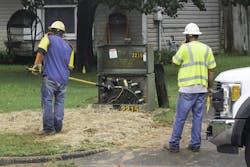Whether at home or in the office, the workplace as we know it has changed dramatically over the past three years; however, one thing that has remained constant is the need for a successful safety culture.
What does that mean? Safety culture is the collection of beliefs, perceptions and values that employers and employees share in relation to safety throughout their organization. This set of shared beliefs offers an impartial and universally applied stability and clarity that supports the mental and physical health and safety of employees.
Creating a Successful Safety Culture
Studies have shown that employees play a vital role in the development and maintenance of a successful safety culture. In one study about organizational culture and employee safety, Gallup analyzed 1.8 million employees in over 82,000 business units across 49 different industries.
The results found that the business units with employee engagement scores in the top quartile of Gallup’s database had 70% fewer safety incidents compared with those units in the bottom quartile.
Workplace stress is one of the primary factors attributed to low employee engagement. The stress may result from a number of factors, including a company’s culture, job insecurity, fatigue or pressure from management. Incidentally, these may all be contributing causes and underlying factors related to safety incidents.
There are some guiding principles for developing a successful safety culture that fosters employee engagement and promotes health and safety in a way that is accepted and mirrored in the actions of all employees.
Make Safety a Core Value
For an organization to have a successful safety culture, safety must be considered a core value as opposed to a priority. What’s the difference? Priorities often change; core values don’t. With safety as a core value, a company reaffirms its commitment to ensuring a safe and healthy workplace for their employees and the communities in which they live.
Promoting Engagement
Encouraging employees to be involved in various safety-related activities not only creates a sense of responsibility, but also engages employees in the process of strengthening safety programs and policies. If employees help establish and enforce safety standards, they are more likely to identify and mitigate hazards on a day-to-day basis.
Company leaders also play a crucial role in employee engagement. By listening to, implementing and reinforcing employee safety recommendations in workplace practices, it demonstrates that employee perspectives and experiences are valued. It’s also important that leadership is modeling desired safety behaviors by “walking the walk.”
Practice Continuous Improvement
It’s essential to look for opportunities to continuously improve a company’s safety culture. Incorporating Human Performance Improvement methodology and analysis into safety practices can help identify root causes of accidents and how to mitigate and avoid them in the future.
As the foundation of most safety management systems, company leaders must support continuous improvement by investing in industry best practices and encouraging employee participation and teamwork.
Measuring Success with Leading Indicators
Companies have traditionally used incident metrics to measure the success of their safety programs and determine if changes need to be made. These metrics, collectively called lagging indicators, track incidents that have already happened (e.g., total recordable incident rate, days away, restricted or transferred rate). In recent years, many organizations have concluded that while lagging indicators do offer some credible data on safety program efficacy, their reactive nature limits their ability to lead to consistent improvements.
To cultivate a successful safety culture, it is important to develop and use leading indicators. As defined by the National Safety Council’s Campbell Institute, leading indicators are “proactive, preventive, and predictive measures that provide current information about the effective performance, activities, and processes of an EHS management system that drive the identification and elimination or control of risks in the workplace.”
Leading indicators are often tailored to an organization, based on its needs. Some common categories include personnel training, hazard identification and reporting, and employee feedback.
Invest in Personnel Training
Employee training is obviously an important part of any successful safety program; however, to be an effective leading indicator, organizations must assess the value it provides.
Is the training curriculum designed to simply meet minimum regulatory standards? Or does it incorporate industry best practices and/or new tools and techniques recommended by credible, safety-focused research? Examples of training-centric leading indicators include tracking attendance and participation in training sessions, monthly hours spent training and leadership participation.
Hazard Identification and Reporting
Recent studies reveal that experienced workers only anticipate 45% of the actual hazards encountered during their workday.
An employee who doesn’t recognize a hazard won’t be able to mitigate it. Along with training, other leading indicator tools can improve an employee’s ability to recognize and mitigate hazards, such as behavior-based safety observations, good-catch reporting and safety audits. These tools can also help gather useful data for creating and/or improving safety programs moving forward.
Organizations with successful safety programs consistently communicate the data gathered by these tools. Safety information shared in project team meetings, through dashboards or even through social media promotes awareness and can help staff identify hazards more proficiently.
Seek Employee Feedback
Requesting workforce feedback can identify areas where your safety program is succeeding, or where it could use some help. With more eyes looking for gaps in your program, more hazards will be identified.
Employee feedback can come in many forms, such as conversations with safety staff or supervisors during observations, or through formal feedback requests and safety surveys. Promptly employing safety solutions implemented from feedback is not only important for its own sake: it also shows your workers that their concerns have been heard and are a priority, making them more likely to continue sharing feedback.
Assess and Adjust
There are many leading indicators that provide valuable, predictive insights into your safety program—and the combination that proves optimal for your organization is the right one. However, they don’t have to be set in stone. If the leading indicators you use today aren’t generating the results you want, reexamine them to determine if other indicators would better meet your needs.
Assessing and adjusting your leading indicators will keep your safety program on the path of continuous improvement—and that, in turn, can improve your employee’s ability to identify and mitigate hazards.
The Bottom Line
A poor safety culture affects a company in more ways than the obvious direct costs associated with injuries and accidents, such as medical payments, increased insurance premiums or worker rehabilitation costs.
Indirect costs can include loss of productivity, disengaged employees, reduced service quality, property damage, time and resources for accident investigations and, ultimately, low morale and culture degradation.
Although it’s a great start, a successful safety culture must expand beyond simply promoting safety to employees. It must be supported throughout the organization—from upper management to part-time employees. A successful safety culture promotes physical and mental health, develops leading indicators, fosters employee engagement and holds safety as a core value.





